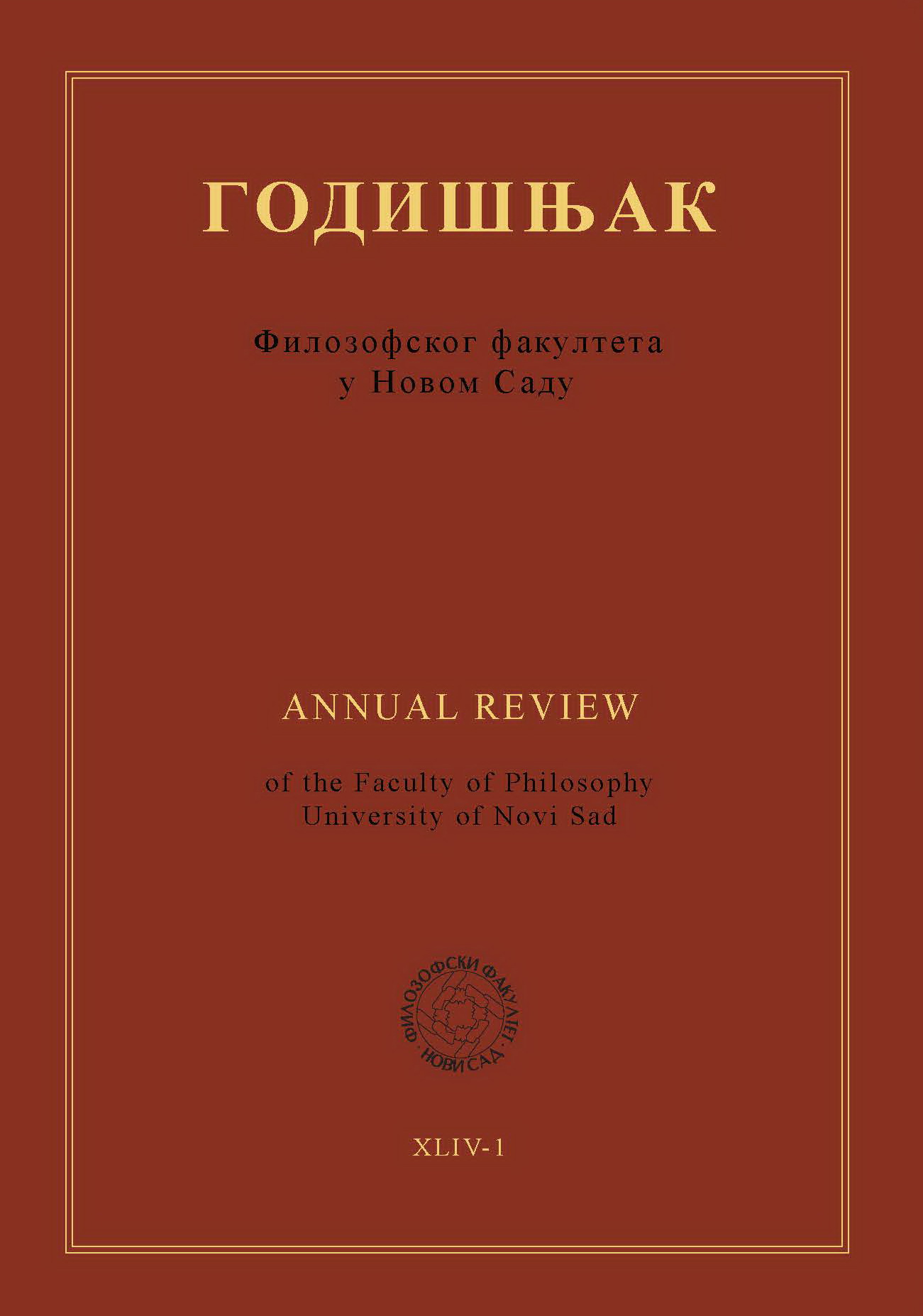EMOTIONAL, MENTAL AND PHYSICAL STATES EXPRESSED THROUGH COLOUR CONCEPTS IN ENGLISH AND SERBIAN: A COGNITIVE LINGUISTIC VIEW
Main Article Content
Abstract
This paper studies the extended meanings of lexemes with the colour concepts red, pink, blue, green and yellow expressing emotional, mental and physical states in English and Serbian from a cognitive linguistic perspective. The initial hypothesis is that lexemes with these colour concepts express states of the mind and/or the body like being angry, unrealistic or sick, for instance, and that these transferred metaphoric meanings are essentially metonymically grounded. The aims are the following:1. to identify the conceptual metaphors associating concrete colour concepts with the abstract concepts of emotional, mental and physical states, 2. to determine metonymic motivation of colour-related metaphors, 3. to consider the issue of cultural universality and/or diversity. The results of the analysis have shown that the studied colour concepts express meanings associated with different states of the mind and the body, which is presented via conceptual metaphors (e.g. being embarrassed is being red, being unrealistic is seeing pink, etc.). Also, most of these metaphors are based on two metonymies: 1. colour of the skin for the state of the mind/body and 2. an experiential association between a particular colour and people`s psychological reaction. There are more similarities than differences between English and Serbian, which is strong ground for believing that the studied metaphors motivated by metonymies are universal.
Downloads
Metrics
No metrics found.
Article Details
References
Barcelona, A. (1986). On the concept of depression in American English: A cognitive approach. Revista Canaria de Estudios Ingleses, 12, 7−35.
Barcelona, A. (2000). On the plausibility of claiming a metonymic motivation for conceptual metaphor. In: Barcelona, A. (ed.). Metaphor and metonymy at the crossroads. A cognitive perspective. Berlin, New York: Mouton de Gryuter. 31−58.
Berlin, B.−Kay, P. (1969). Basic Colour Terms: Their Universality and Evolution. Berkeley: University of California Press.
Croft, W.−Cruse, A. (2004). Cognitive Linguistics. Cambridge, UK: Cambridge University Press.
Evans, V.−and Green, M. (2006). Cognitive Linguistics. An Introduction. Edinburgh: Edinburgh University Press Ltd.
Filipović-Kovačević, S. (2014). Conceptual Metaphors in English and Serbian Colour Idioms with Red, Pink, Green and Yellow. U: Gudurić, S.–Stefanović, M. (ur.). Jezici i kulture u vremenu i prostoru, 4/1. Novi Sad: Filozofski fakultet. 121−133.
Filipović-Kovačević, S. (2015). Prenesena značenja leksičkih jedinica s pojmom plave boje u engleskom i srpskom jeziku (kognitivnolingvistička analiza). Zbornik Matice srpske za filologiju i lingvistiku, 58/2, 149−167.
Goosens, L. (1990). Metaphtonymy: The interaction of metaphor and metonymy in expressions for linguistic action. Cognitive Linguistics, 1/3, 323−340.
Goosens, L. (2002). Metaphtonymy. The interaction of metaphor and metonymy in expressions for linguistic action. In: Dirven, R.–Pörings, R. (eds.). Metaphor and metonymy in comparison and contrast. Berlin, New York: Mouton de Gruyter. 349–378.
Johnson, M. (1987). The body in the mind: the bodily basis of meaning, imagination, and reason. Chicago: University of Chicago Press.
Kövecses, Z. (1986). Metaphors of anger, pride and love. Amsterdam: John Benjamins.
Kövecses, Z. (1988). Language of love. Semantics of passion in conversational English. Lewisburg: Bucknell University Press.
Kövecses, Z. (1990). Emotion concepts. New York: Springer Verlag.
Kövecses, Z. (1991). Happiness: A definitional effort. Metaphor and Symbolic Activity, 6/1, 29− 46.
Kövecses, Z. (1995). Anger: Its language, conceptualization and physiology in the light of cross-cultural evidence. In: Taylor, J.−MacLaury, R. E. (eds.). Language and the cognitive construal of the world. Berlin, New York: Mouton de Gruyter.
Kövecses, Z. (2002). Metaphor. A Practical Introduction. Oxford: Oxford University Press.
Kövecses, Z.−Radden, G. (1998). Metonymy: Developing a cognitive linguistic view. Cognitive Linguistics, 9/1, 37−77.
Krimer-Gaborović, S. (2011). Semantička i tvorbena sintagmatika leksema kojima se imenuju boje u engleskom i srpskom jeziku: kognitivnolingvistički pristup. (doktorska disertacija, neobjavljena). Novi Sad: Filozofski fakultet.
Krimer-Gaborović, S. (2014a). Konceptualizacija, kategorizacija i imenovanje boja u engleskom i srpskom jeziku u svetlu Berlin-Kejovog modela. Zbornik Matice srpske za filologiju i lingvistiku, 57/2, 217−245.
Krimer-Gaborović, S. (2014b). The semantics of the blue colour category in English and Serbian. In: Prćić, T.− Marković, M. (eds.). Festschrift in Honour of Draginja Pervaz. English Language and Anglophone Literatures in Theory and Practice. Novi Sad: Faculty of Philosophy. 239− 256.
Mandić, S. (2017) . Meanings of white and black in English and Serbian idioms: a contrastive analysis. Zbornik za jezike i književnosti Filozofskog fakulteta u Novom Sadu, 7, 71−85.
Lakoff, G. (1987). Women, fire and dangerous things. What categories reveal about the mind. Chicago: Chicago University Press.
Lakoff, G.−Johnson, M. (1980/2003). Metaphors We Live by. Chicago, London: The University of Chicago Press.
Lee, D. (2001). Cognitive Linguistics. An Introduction. Melbourne: Oxford University Press.
Rosch, H. E. (1972). Universals in Colour Naming and Memory. Journal of Experimental Psychology, 93/1, 10−20.
Ungerer, F.−and Schmid, H. J. (1996). An Introduction to Cognitive Linguistics. London, New York: Longman.
Vlajković, J.−Stamenković, D. (2013). Metaphorical expressions of the colour terms black and white in English and Serbian. U: Živančević Sekeruš, I. (ur.). Međunarodni interdisciplinarni simpozijum Susret kultura 6/1. Novi Sad: Univerzitet u Novom Sadu, Filozofski fakultet. 547−558.
Whorf, B.L. (1956). The Relation of Habitual Thought and Behaviour to Language. In: Carroll, J. B. (ed.). Language, Thought and Reality: Essays by B. L. Whorf. Cambridge, MA: MIT Press.
Taylor, J. (1995). Linguistic categorization. Prototypes in linguistic theory. (2 nd. edition.) Oxford: Clarendon.
SOURCES
Kovačević, Ž. (1997). Englesko-srpski frazeološki rečnik. Beograd: Filip Višnjić.
Milosavljević, B.−Vilijams-Milosavljević, M. (1996). Srpsko-engleski rečnik idioma. Beograd: Srpska književna zadruga.
Otašević, Đ. (2012). Frazeološki rečnik srpskog jezika. Novi Sad: Prometej.
Vujanić, M.−Miroslav Nikolić, M. (2007). Rečnik srpskoga jezika. Novi Sad: Matica srpska.
INTERNET SOURCES
https://www.etymonline.com/ (February−March, 2019)
http://idioms.thefreedictionary.com/ (February−March, 2019)
https://www.ldoceonline.com/(February−March, 2019)
https://www.phrases.org.uk/(February−March, 2019)
https://katerinamichouli.wordpress.com/the-four-temperament-types-of-hippocrates-wikipedia/ (February−March, 2019)
http://www.greekmedicine.net/b_p/Four_Humors.html (February−March, 2019)
http://www.greekmedicine.net/b_p/Four_Temperaments.html (February−March, 2019)




